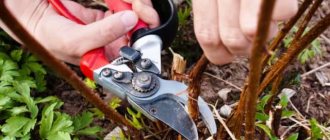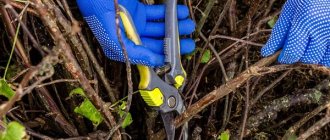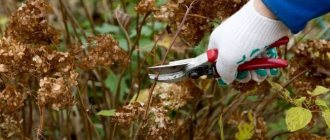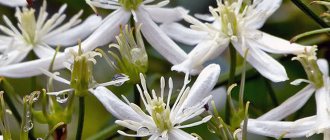How to extend fruiting until the end of summer
Remontant raspberries are increasingly beginning to appear on gardeners' plots. It is better than ordinary raspberries in that the ordinary one already stands without berries, while the remontant one blooms again and gardeners can’t wait to see the fragrant berries. And this continues until frost.
Now every novice gardener will think: how to distinguish remontant raspberries from ordinary ones? Externally there are differences, but this is for a knowledgeable gardener. If it’s August and the bushes are still full of unripe berries, then you have one of the varieties of remontant raspberries growing. Another difference: at the end of summer, flowers and fruit ovaries begin to appear on annual shoots.
Once again about the differences between remontant varieties of this berry crop and ordinary ones:
- The remontant one is capable of producing crops twice a year if it is not pruned, and the usual one - only once.
- This variety produces more yield, even if pruned in the fall.
- With autumn pruning, one crop ripens closer to September, and ordinary varieties of berry crops bear fruit in June - July.
- Regular raspberries produce berries for only two to three weeks, while remontant raspberries, even with a single harvest, last for about two months.
- In long-bearing raspberries, flowers and fruits are located throughout the stem, even in the lower axils of the leaves, while in ordinary raspberries only at the ends of the shoots.
- Long-bearing varieties are self-pollinating and do not need additional pollinators.
- The taste of the fruit is also different. This can only be appreciated by tasting the berries of these two types.
- The most important difference: ordinary varieties are not so demanding in terms of planting location, care, and fertilizing, while remontant varieties require more care.
- The repair plant is less likely to be affected by pests.
Treatment of diseases
If the plantings are very thick, the soil is constantly wet and does not dry out, and last year’s leaves have accumulated at the base of the stems, there is a danger of developing:
- anthracnose;
- gray rot;
- rust;
- spotting;
- mosaic;
- stem and root cancer.
The first symptoms of most diseases are a change in the color of the leaves, their withering or curling, the spread of colored spots over the surface, in place of which dried areas or holes later appear. You should also be alert for swelling of the stem, the appearance of cobweb threads, and rotting of fruits and ovaries.
The main causative agent is fungi, but bacterial causes are also found. For preventive purposes, they are sprayed with Bordeaux mixture and copper-containing preparations.
You need to remember: chemicals have a certain period during which the treated fruits cannot be eaten. It is better to give preference to folk remedies and properly care for the bushes.
Caring for raspberries starting in spring
In order for the raspberry tree to be free from pests and produce a large harvest, it must be well looked after, starting in spring. Already in April it should be sprayed with Bordeaux mixture, following the recommendations in the instructions. In summer, during flowering, you can treat them with biological products against pests.
As soon as you notice that the bushes are pale green and weak, immediately add humus (5-6 kg per 1 sq.m.). Fertilizing with a solution of chicken manure (1:20) or mullein (1:10) works well at the rate of 3-5 liters of ready-made fertilizer per 1 sq.m of planting.
Apply complex fertilizers in March-April. Do not forget to apply phosphorus-potassium fertilizers in the spring and during flowering (50-80 g of superphosphate and 40 g of potassium sulfate per 1 square meter).
Below are some summer tips for beginners:
- If you haven’t purchased fertilizer, then collect a bucket of weeds, fill it with water, and let it sit for a week.
- Then dilute at the rate of: 1 liter of infused liquid per bucket of water, spray the bushes, repeat spraying after a week.
- Feed the plants at the roots with the same liquid once a week.
How to treat before sheltering for the winter
It’s not enough to feed raspberries in the fall. It needs high-quality treatment, because the plant can be affected by pathogenic bacteria. Pests can also attack raspberries.
After the fallen leaves have been removed, pruning has been done and the soil has been dug up, the bushes must be carefully processed.
After trimming
Raspberries should be processed in dry weather.
Gardeners praise Bordeaux mixture - it is a universal remedy that helps in the treatment of many fruit and berry plants. The solution is prepared as follows: 300 g of the finished drug is diluted in 10 liters of water. The filtered solution is sprayed onto the bushes.
Good treatment with urea. You need to dissolve 700 g of urea in a bucket of water, add copper sulfate, two and a half tablespoons. Then spray the bush. By the way, treatment with urea can be carried out both in spring and summer.
From diseases
A solution of copper sulfate will cope with fungal diseases. Moreover, it is necessary to treat not only the branches, but also the ground around the bush.
Other means will also come to the rescue. So, for late blight, which can be identified by the characteristic dark red coating on the rhizome, you will need “Paurin”. You can get rid of gray rot using Fitosporin-M. If the tops of the bush wither and spots appear on the roots, you need to take Previkur and Vitaros. Topaz will help with chlorosis. If ulcers appear on the stems and the leaves suddenly turn yellow-orange, then the raspberries are suffering from rust. “Forecast” can cure a plant. You can also use Bayleton.
How to treat currants in the fall against pests and diseases
From pests
Insecticides will help against insects - spider mites or raspberry beetles, weevils and other pests. These are “Fufanon”, “Intavir”, “Aktellik”. Solutions are prepared according to instructions.
Folk remedies will also help against the raspberry beetle. For example, you can take marigolds and wormwood. Make an infusion. For 100 g of marigolds, the same amount of wormwood is taken. Separately, in different containers, marigolds and wormwood are infused. Then the solutions are combined. This infusion should be used to treat the soil under the raspberry bushes and the plant itself.
You can get rid of kidney moths thanks to Korfidor, Iskra, and Decis. A prerequisite is that you must first remove all dry foliage.
“Nitrafen” and “Karbofos” will help against glassworm, a caterpillar that destroys shoots.
Gardeners also use natural pest control. It is made from mustard and water. This is done like this: 100 g of dry mustard powder is diluted in 5 liters of water. Then the bushes are sprayed.
How to get rid of aphids in the garden forever
How to treat for gall midges
Raspberry gall midges are small mosquitoes that lay eggs in young shoots. This is a real scourge, because caterpillars emerge from the eggs and destroy the shoots.
You can get rid of gall midges using a simple but effective remedy. You will need chlorophos and karbofos. In 10 liters of water you need to dilute a tablespoon of chlorophos and one and a half tablespoons of karbofos. Treat the bushes with the solution. By the way, such treatment will also be needed in the spring.
There is another method, a folk one. Take garlic and chop it. Garlic must be placed in water. For half a kilo of garlic take 8 liters of water. The infusion should stand for 24 hours, no less. Then put 20 g of laundry soap into it. Everything is mixed. The remedy against gall midge is ready. After the first treatment with the solution, four days should pass, then the bushes must be thoroughly sprayed again. And then the crimson gall midge is not scary.
Watering raspberry bushes
In summer, remontant raspberries need abundant watering. If there is no extreme heat, and it rains only occasionally, then watering is carried out once a week - 2 buckets per 1 square meter. meter. During flowering and ripening of berries, this type of raspberry especially needs watering to a depth of 30-40 cm. This is the only way the roots will be able to extract nutrients from the soil.
To prevent the soil under the bushes from drying out, it must be covered with mulch. Mulch will make caring for plants easier: weeds will not grow, and you won’t have to water and loosen frequently. As mulch, you can choose peat, sawdust, humus, mown grass, or cover it with black spunbond.
If you cannot do without loosening, then you need to loosen it very carefully, because the roots of this plant are located close to the surface. The first loosening is carried out before the buds open, and the subsequent ones, when you see that weeds have appeared or the soil has dried out very much.
The last loosening of the soil is carried out after the real cold snap. This loosening is important for the destruction of pests overwintering in the soil.
Garter bushes
Tie the raspberries so they don't fall to the ground. Many gardeners place a net around the bush, so the raspberries do not shade neighboring plantings and do not lean toward the ground.
Tips for tying bushes:
- To prevent shoots from breaking off under the weight of the harvest when planting in bushes, tie them to long pegs. When planting in rows in trenches - to the trellises.
- It is recommended to tie bushes from which it is planned to collect two crops in this way: tie one-year-old shoots on one side, and two-year-old shoots on the other. This way you won’t confuse one-year-olds and two-year-olds.
Snow retention
If the bushes are located in an open space where windy weather often occurs, then it is important to take care of snow retention. To do this, a fence is installed on one side of the row of remontant raspberries. It consists of sheets of plywood or polycarbonate, since these materials are not affected by low temperatures and do not rot.
Snow barriers are fixed to trellises, between which rows of wire are stretched. When preparing, it is more advisable to install such structures from the direction of the winter wind.
In some regions, a small amount of snow falls during the winter or it disappears, despite the installed fences. In this case, the remontant raspberry bushes must be additionally covered with non-woven material, for example, spunbond.
During preparation, the lashes are bent as low as possible to the ground and securely fixed to the wire, and covered with cloth on top, securely attaching it to the trellis.
If the winter is not snowy, but the frosts are severe, then you can make reliable protection with a gable roof using curved polycarbonate sheets. Thanks to this solution, remontant raspberries can easily survive frosts and strong winds.
Proper harvesting
Harvesting the berries of this variety of berry crop is special. It must be removed with the stalk. Cut the berries together with the stalk, then you will collect all the pests, they will not fall and burrow into the ground. Make sure that the berries do not fall to the ground, otherwise shoots will appear from them, which will thicken the plantings.
Don't drop berries on the ground for two more reasons:
- Pests from the berries will spread diseases throughout the area.
- Sifted seeds will contribute to the degeneration of the variety.
- To prevent the berries from falling into the ground, the crop must be harvested every 2 days.
- You need to pick raspberries over some container so that the berries do not end up on the ground.
- To protect against pests, do not leave wilted and wormy berries on the bushes.
Preparing raspberries for cold weather
Preparing for winter is an important component of caring for long-bearing raspberries. In the fall, a number of events are necessarily held that create better conditions for wintering and ensuring a good harvest of berries for the next season.
Step-by-step preparation for winter: after leaf fall, which occurs in late autumn, the entire above-ground part of the bushes must be cut back to the very root. If you carry out this work, you can expect abundant fruiting on new shoots next year in August - September. In a word, fruiting will last until frost.
Trimming scheme
Pruning is a mandatory procedure. It is carried out in two ways. If you want to get one, but very rich harvest, you need to trim the bushes completely to the very root after the leaves fall.
Is it necessary to prune if it is desirable to get the harvest all summer? You should prune raspberries this way: leave young strong branches, and cut out old shoots (with brown bark), not even leaving stumps. Young branches are shortened by 15-20 cm.
If you managed to plant remontant raspberries this year, then the shoots are shortened in such a way that 20-30 cm remain from the bush. This is done so that the plants can use all the nutrients from the stem and leaves to strengthen the root system.
When new shoots appear in the spring, these old branches are removed. It is important to form the bush correctly. Only 6–8 shoots should be left on one root.
Once again about the cutting scheme. If you want to get one rich harvest, then in the fall after the leaves fall or in the spring, even before the buds open, cut out all the branches without leaving stumps.
If you want to collect two, but not too large, harvests, in the fall or early spring, cut out all shoots with a brown color, all weak basal shoots, and for green annuals, cut off the tops by 15-25 cm.
Young bushes are not pruned at the root in the first autumn after planting. They leave before winter with stems about 20 cm high.
Disembarkation dates
In the Russian climate, remontant varieties are recommended to be planted in the last week of September or at the very beginning of October. If you do this on time, the plant will have time to prepare for the winter cold. This will also allow the raspberries to actively begin to grow in the spring months.
It is better not to carry out this procedure ahead of schedule, since experts say that by the beginning of September the plant’s root system has not yet been fully formed. Because of this, raspberries may simply not take root. Remontant varieties are famous for their ability to grow well in fairly harsh climatic conditions. At the same time, fruiting remains at a high level .
Healthy!
You can plant raspberries in both the spring and summer months, but you need to remember that all seedlings must be covered with sawdust, snow or straw for the winter. This will preserve the roots even in severe frosts.
Plants should be planted either in a straight row or in separate bushes. A minimum gap of 1 meter between seedlings should be maintained. The holes for the future bush should be shallow. It is also advisable to treat the plants with special fertilizers. After planting, the soil must be compacted well.
How to propagate remontant raspberries
Raspberry bushes can be propagated in the spring using the “nettle” method. When the raspberries begin to germinate, releasing shoots 10 cm in height, they can be used for planting. It is important that they already have two full leaves.
Nettle method
What to do to transplant using the “nettle” method:
- Rake away soil from the base of the shoot.
- Cut off the shoot along with the underground part of the white stem (it should reach 3-5 cm in length).
- It is recommended to treat cut shoots with drugs that activate growth.
- To plant, mix peat and sand, then plant the young seedling so that the white underground part and part of the green shoot remain underground.
- Pour warm water
- If planting is carried out in open ground, then young seedlings should be covered with bottles to create a greenhouse effect.
After a few weeks, the young plantings should take root. Once strengthened, raspberries can be transplanted to a permanent location. When to plant? Toward the end of June is the time to plant in a permanent bed.
Planting by cuttings
For propagation by cuttings, you need to select healthy young shoots. Reproduction takes place in summer:
- Cut off green young shoots close to the base.
- Place in water, dissolving the growth stimulator.
- When fairly large roots appear, the seedlings must be transplanted into fertile, moist soil.
- New plants require abundant watering and the application of complex fertilizers.
You can plan to plant woody cuttings in September-October. For this procedure, you should choose healthy annual shoots that have already become lignified.
Cuttings in autumn:
- Cut cuttings 20-25 cm long.
- Remove the leaves on the cuttings so as not to take away nutrients.
- Dig holes, place the cuttings in the holes so that two buds remain on the surface.
- Cover with agrofibre, you can use spruce or pine branches.
- In the spring, cuttings rooted in the fall will actively begin to grow.
In spring, you can also propagate using lignified cuttings. To do this, cut the stems using the same method, place them in boxes with damp sand, and put them in the refrigerator. In March, root the cuttings, and with the onset of warmth, plant them in the ground.
Dividing the bush
In the fall, that is, in September-October, 2-3-year-old bushes should be divided into several parts, each part transplanted to a new place. After planting, mulch the soil so that the bush does not die.
Reproduction from the mother bush
Root cuttings are suitable for propagation - this is a part of the rhizome with branches going to the side.
- For propagation, you need to take roots 2-5 mm thick.
- In the spring they are separated from the mother bush after it is covered with leaves.
- Then they are planted in holes 5-8 cm deep, covered with soil, lightly compacted and watered with warm water.
- After planting, the cuttings should be covered with film to create a greenhouse effect.
- The film is removed after green leaves appear. But it is better to protect the seedlings themselves from wind and sun. When the seedlings become stronger, the protection is removed.
Stem cuttings
In summer, horizontal annual layerings should be pressed to the ground and covered with earth. As soon as the stem begins to grow foliage, it is separated from the mother bush and planted in the chosen place
Seeds
If you really want to grow your favorite raspberry variety, then take seeds from the largest berries and grow them in the same way as all garden plants.
Controlling growth and mulching the soil
In addition to pruning, it is important to prepare the bushes for subsequent operations. Raspberry overgrowth can be a big problem.
The special structure of raspberry roots causes the shoots to continuously spread in different directions, so a regular garter will not be enough. The branches will very quickly fill the entire space between the rows. To prevent this, you will have to regularly cut off young shoots. This way they will not interfere with the growth of quality shoots. An excellent way to solve the problem is to install a barrier made of sheet metal or slate.
Advice!
It is also important to mulch the soil. The raspberry root system is approximately 15 cm from the surface. Therefore, in the summer, the roots can dry out greatly, and in the winter they can freeze. This necessitates mulching.
Mulching will create a balance of temperature and humidity, and the surface of the soil will not be covered with a crust, and the roots will be able to consume oxygen in abundance. It is necessary to mulch the soil to about 7 cm. This procedure should be carried out immediately after planting. For additional feeding in September, mineral fertilizer is usually scattered in the space between the rows. The mulch layer should be made of humus, straw and sawdust.
By pruning raspberries, you can significantly increase the yield and quality of the berries. This will also protect the plants from diseases and parasites. In addition, raspberries will not turn into a weed that spreads throughout the garden.











